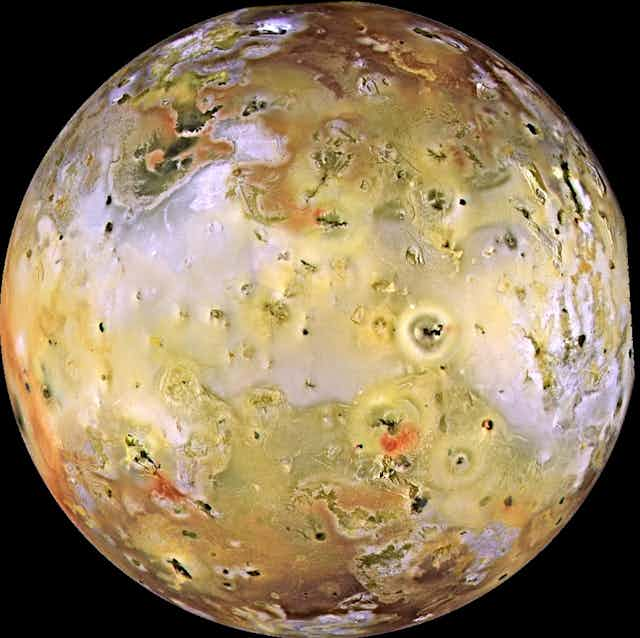Evidence for current volcanic activity on the planet Venus has recently made the news. But Venus is far from the only world beyond Earth to exhibit signs of volcanic activity.
In fact, having volcanic activity (volcanism) on planets is quite common. Here are four worlds which have boasted active volcanism, from Mars to the far flung reaches of the outer Solar System.
1. Mars
Active volcanoes on Mars have not been directly observed, however, signs of volcanism are abundant on the Martian surface. Chief among them is the aptly named Olympus Mons, the tallest known volcano in the Solar System.
Olympus Mons stands at approximately 26km above the surrounding terrain, is roughly twice as high as Mount Everest, and is topped by a volcanic caldera some 70km across. The base of Olympus Mons is the size of Poland. The volcano is flanked by many solidified lava flows, the most recent of which are only a couple of million years old, making them geologically recent.
Like many of Earth’s volcanoes, Olympus Mons is a basalt “shield volcano”, so termed because it has gentle slopes and a profile which resembles a shield laying on its side. A similar volcano on Earth is Mauna Kea in Hawaii. Elsewhere on Mars, a recent study has argued that another volcanic region, Elysium Planitia, is active today and powered by a sub-surface mantle plume similar to those which power volcanic hotspots on Earth.

The study used seismic data collected by Nasa’s Insight lander spacecraft, which has detected numerous “Mars quakes” emanating from this region.
2. Ceres
The largest asteroid in the main asteroid belt is Ceres. It is a small world of just under 1,000km in diameter which orbits the Sun between Mars and Jupiter once every 4.6 years. It was visited for the first time by a robotic spacecraft in 2015 – Nasa’s Dawn mission. One of the most interesting discoveries of this mission was the volcano Ahuna Mons.
Most of Ceres’ surface is covered by impact craters, some of which show salt deposits inside them. However, Ahuna Mons stood out as an approximately 4km high mountain towering over the surrounding terrain. It is the only feature of its type on Ceres, and its flanks are covered with deposits of carbonate salts.

The mechanism for the formation of this mountain is believed to be cryovolcanism, where liquid salty water rather than lava is ejected. On Ceres, these salt-water eruptions are produced due to the pressure from the asteroid’s icy surface. As the erupted water evaporated away under the vacuum of space, it left behind salt deposits. Ahuna Mons is the nearest known cryovolcano to the Sun.
3. Io
Io is the innermost large moon of Jupiter and orbits the host planet once every 43 hours. It was discovered by Galileo in 1610 and is about the same size as Earth’s Moon. But unlike our quiet celestial neighbour, Io is the most volcanically active body in the Solar System. Io has been surveyed several times by robotic spacecraft and by telescopic observations from Earth.
Its surface is a distinctive yellow-red colour owing to vast deposits of sulphur, much of which has been erupted from the more than 400 active volcanoes on its surface. The source for much of the energy for all these volcanoes comes from tidal forces due to the proximity of the second nearest large Jovian moon, Europa, and the largest Jovian moon, Ganymede.
Io completes two orbits of Jupiter for every one orbit by the moon Europa, and four orbits of Jupiter for every one orbit of Ganymede. Hence, Io frequently lines up with one of these other moons and is stretched by the powerful gravity of Jupiter in one direction and the aligned gravitational fields of the outer moons in the other.
This continuous flexing releases large amounts of heat, which helps to keep the interior of Io molten and drive volcanism on its surface. Some of the most spectacular volcanoes of Io erupt plumes of material hundreds of miles above Io’s surface, as seen in the animation below.

Io is quite the tortured world, with a surface pockmarked by violent volcanoes and showered with highly ionising radiation radiation from Jupiter’s radiation belts – even generating aurora in the moon’s thin atmosphere.
4. Pluto
Pluto lies in the Kuiper Belt, an extended region of icy dwarf planets in the distant outer Solar System, of which Pluto is the largest known member. It orbits the Sun once every 247 years and the heat from the Sun at this distance is so feeble that Pluto’s average surface temperature is a frosty -230°C.
However, despite these frigid conditions, Pluto is an active world with many features of interest, including a thin atmosphere and glaciers made from frozen nitrogen.

The first and, so far, only robotic visitor from Earth was Nasa’s New Horizons mission which famously flew past the ice dwarf, and its moon Charon, in 2015. One remarkable feature discovered was Wright Mons.
This large mountain is about 150km across and over 4km high, with a distinctive large depression at the summit. The absence of recent meteorite impact craters on this feature strongly suggest that it is young, geologically speaking.
Wright Mons also resembles a shield volcano. It is believed to be a cryovolcano similar to those found on Saturn’s moon Titan and Ceres, but it is the largest such feature known in the Solar System. The true nature of this intriguing mountain is still not fully agreed upon.

